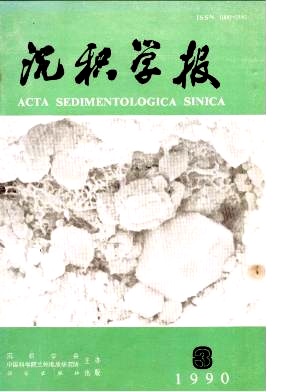ON SEDIMENTARY GEOCHEMISTRY OF SILICEOUS ROCKS ORIGINATED FROM THERMAL WATER IN NANDAN-HECHI BASIN
- Received Date: 1988-02-11
- Publish Date: 1990-09-10
Abstract: The Nandqn-Hechi Basin in Cuangxi Province is an elongated extensional basin, which came to existence in a carbonate platform in the Late Palaeozoic Era. During the Late Devonian, the "intra-platform trough" fades, a special type of sedimentary facies, was developed. The siliceous rocks (D31), which are an important part of the facies, were typically deposited by silicon-bearing thermal water. The paper indicates that: (1) Sb (90ppm), As (16ppm), Ag (800ppb) and Ca (100ppm) -richer, and REE (13ppm) -poorer, compared with the element abundances of sedimentary rocks (Sb 1ppm, Ag 9ppm, Ag70ppb, Ga 15ppm, REE184ppm), is one of the most important charecteristics of thermal water sediments. (2) According to the results of Fuzzy Cluster, Factor Analysis and Correspondence Analysis, the relations between types of siliceous rocks and element associations can be described as below: silicalite with argillaceous silicalite shaly argillo-silicalite jasperoid→ → → laminated strcture with massive structure (-As,V) (As,-V) (-Cu,Sb,Ag,V) (Pb,Zn-Ga) (Al2O3,TiO2,K2O,MgO-SiO2) (FeO,MnO) (Fe2O3) (3) From near the spring open of silicon- bearing thermal vater outforward, is such a typical sedimentary and geochemistry sequence as : Sb, As, Ag and Ga rich, V and Cu poor, and good positive correlation between FeO and MnO (r (FeO, MnO) =0.87; n=10, below is the same) →Pb, Zn and Ni relatively rich, and corrlated with Fe2O3 (r (Pb, Fe2O3) =0.91; r (Zn, Fe2O3) =0.88; r (Ni, Fe2O3) =0.71) →V rich, Sb, As and Ag relatively poor, and excellent linear correlation between A12O3, TiO2, K2O, MgO and SiO2 (r (A12O3, TiO2) =0.86; r (A12O3, K2O) =0.99; r (A12O3, MgO = -0.95; r (A12O3, SiO2) =-0.95). (4) Sn is one of the most important ore-forming elements in the basin, and its content (1.1ppm), which is not high compared with Sn abundance of sedimentary rocks (3.9ppm), may be derived partly from silicon-bearing thermal water. (5) The values of δCe, Standardized by the rare earth element average of the shales in Northern America, of jasperoid and sillicalite with laminated structure are higher than those of argillaceous silicalite with massive structure. This suggests that the depositional velocity of siliceous muds near the spring open of thermal water is higher than that far away from the spring open.
| Citation: | Zhou Yongzhang. ON SEDIMENTARY GEOCHEMISTRY OF SILICEOUS ROCKS ORIGINATED FROM THERMAL WATER IN NANDAN-HECHI BASIN[J]. Acta Sedimentologica Sinica, 1990, 8(3): 75-83. |






 DownLoad:
DownLoad: